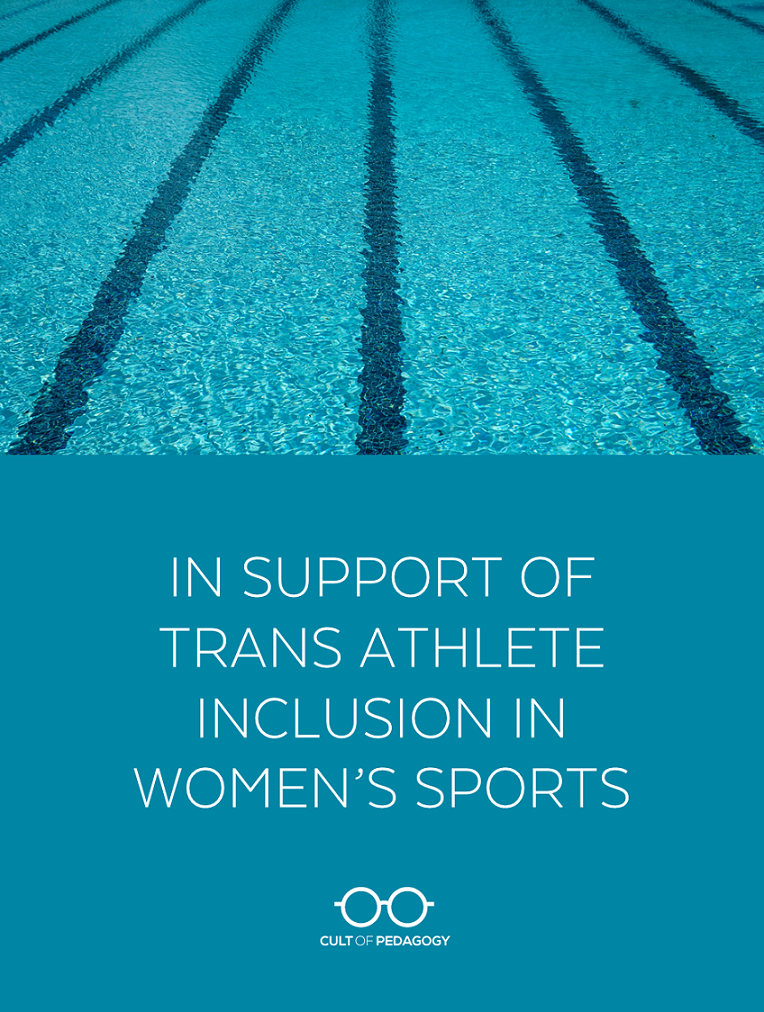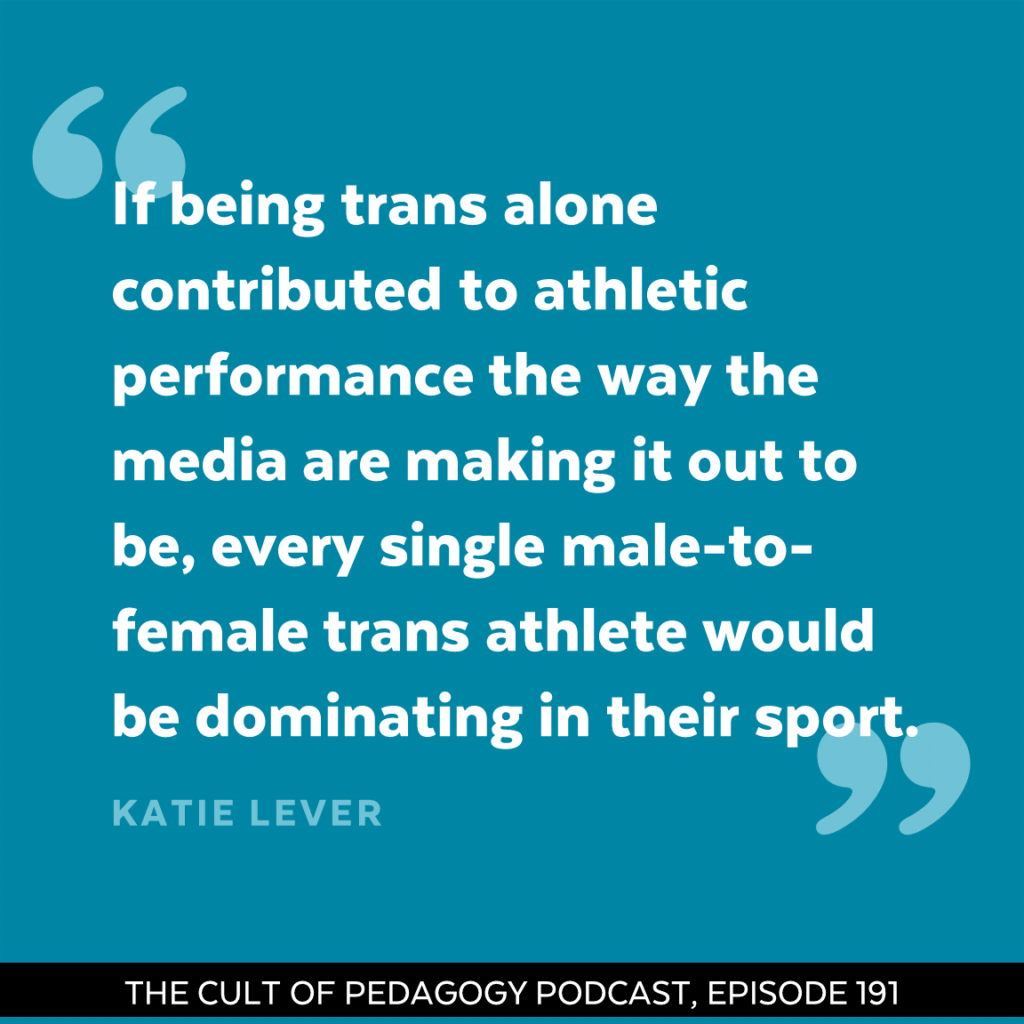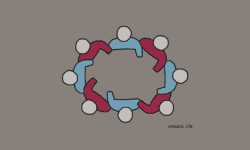
Listen to the interview with Katie Lever:
Sponsored by Pear Deck and Spinndle
This page contains Amazon Affiliate links. When you make a purchase through these links, Cult of Pedagogy gets a small percentage of the sale at no extra cost to you.
What if I told you that trans athletes aren’t a threat to women’s sports? I know it’s not a popular point of view—I’ve heard trans female athletes be called everything from cheaters to thieves to threats, but as a former Division 1 athlete and current doctoral candidate who studies college sports, I see this discourse as alarmist, degrading, and misleading. I’d like to use the recent Lia Thomas case to illustrate why I believe this is true and to offer five reasons I support trans athlete inclusion in women’s sports.
1. Lia Thomas has abided with the NCAA’s guidelines.
Thomas has done nothing wrong, and her participation is in line with NCAA guidelines for transgender athletes. Whether or not those guidelines are sufficient to ensure fairness will be revealed in time (more on that later). But for now, it’s not right to leverage vitriol at Thomas for abiding by the NCAA’s rules. Criticism should be aimed at the institution, not the athlete.
2. Hormone therapy reduces athletic performance substantially.
There’s still a lot we don’t know about trans athletes and there are still countless unknowns about the human body and athletic performance. This uncertainty extends to our knowledge about the effects of hormone replacement therapy (HRT) on trans athlete performance. Thomas actually provides a compelling case for the inclusion of trans athletes in women’s sports post-HRT. But that’s only if we look at her athletic performances in the correct context.
There is a common narrative circulating that pre-transition, Thomas was somewhere around the 450th best male swimmer in the nation. However, what some outlets fail to account for is the fact that at the time of that ranking, Thomas was in the middle of testosterone-mitigating HRT. During Thomas’s transition, the NCAA’s trans athlete inclusion rules required male-to-female trans athletes to undergo at least a year of HRT before they could compete for a women’s team (The NCAA has since amended their policies). While Thomas was in the middle of her transition, she competed alongside men, hence her lower standings on the men’s national rankings list.
Pre-HRT, Thomas was one of the top-ranked Ivy League swimmers as a freshman and sophomore. Her freshman year, she placed in the top eight in the Ivy League Championships in the 500-yard freestyle, the 1,000-yard freestyle, and the 1,650-yard freestyle. As a sophomore, she placed second in the same races, earning multiple All-Ivy team honors, getting closer to her goal of swimming at the NCAA championships and “perhaps qualifying for the ’20 Olympic trials,” according to Sports Illustrated.
Then, as a junior, Thomas began HRT while still competing against men and understandably fell in the men’s rankings because that’s what testosterone suppression does to athletic performance. Thomas was in the process of transitioning but still had to compete against men at a significant disadvantage because that’s how the NCAA ensures fairness.
In short, much of the media are misrepresenting Thomas. She actually provides evidence that HRT works in trans athletes exactly the way it was intended to.
There’s also the fact that there are other male-to-female trans athletes in the NCAA, both now and in the past, who have not dominated women’s sports.
- Natalie Fahey, the first-ever openly trans female swimmer in the NCAA, competed for Southern Illinois University from 2015 to 2019. Fahey began HRT in 2018 and the drop in her performances can be tracked in her athlete bio, which lists her pre-transition times, and her SwimCloud page, which lists her mid-transition times. In 2019, Fahey wasn’t done with her HRT timeframe as prescribed by the NCAA, so she competed in the Missouri Valley Conference Championships as an exhibition swimmer, meaning that although she swam against women in the meet, her scores would not count. Fahey would have barely edged out the top swimmers at the championship while still having months to go to complete her HRT. Even so, Fahey’s time in the 500-yard freestyle slowed down by over 17 seconds and her time in the 1,605 freestyle slowed by over a minute in a single year. That’s far from domineering, and Fahey’s times would have likely continued downward had she continued competing throughout the completion of HRT.
- Juniper Eastwood competed in track and field and cross country for the University of Montana from 2015-2019. Eastwood’s resume in terms of standings contains mixed results. On one hand, her best placing in the MAC indoor track championship history did improve from seventh in the men’s mile to first in the women’s 1,500 meters over the course of her transition, but other races show a different dynamic completely. In 2018 (listed as Jonathan Eastwood), she placed 22nd in the men’s 3,000 meters and in 2019, she placed 15th in the same women’s event, meaning that although her placing improved, she did not improve enough to even score in a conference event (in track, the top eight finishers in each event contribute to an overall team score). Cross country is difficult to compare directly, as women run distances ranging from 5,000 to 6,000 meters, whereas men run anywhere from 5,000 to 10,000 meters. However, in Eastwood’s most recent regional performances, she shows a decrease from 58th place in the 2017 men’s Mountain Region Cross Country Championships to 60th in the women’s 6,000 meters two years later. Throughout the course of her HRT, her performances continued to decrease, and, like Fahey, she was far from domineering. Furthermore, Eastwood told Runner’s World that although her recent performances were slower than her times on the men’s teams, she felt an increased sense of confidence amid her transition, which may account for her better placing in women’s events.
- Johanna Harper, a master’s trans runner who is also a medical physicist at Providence Portland Medical center, has both experienced the performance-mitigating effects of HRT on athletes and is one of the few individuals on the planet who is studying it. Of the fear that trans athletes will dominate cis women, she aptly states that trans women, like Fallon Fox, Mianne Bagger, and Renee’ Richards, have been competing in women’s sports for decades without dominating the rankings. Additionally, Harper notes of her own times post-transition: “When I looked up my times in USA Track & Field’s age-grading tables — used to compare runners of all ages and both sexes — I found that I was just as competitive as a 48-year-old woman as I had been as a 46-year-old man.”
- Outsports estimates that there have been 33 out trans athletes in the history of college sports, none of whom have been overwhelmingly dominant in their respective sports like cisgender male athletes are dominant over cisgender female athletes. Thomas has likely been the only trans athlete making headlines lately because she is an exceptional athlete, male or female, cis or trans. If being trans alone contributed to athletic performance the way the media are making it out to be, every single male-to-female trans athlete would be dominating in their sport.

Therefore, if Thomas was truly at a huge biological advantage on par with cisgender men, she would have dominated every event she competed in, but that was not the case: She won the 500-yard freestyle, but tied for fifth in the 200 yards and placed eighth in the 100 yard freestyle. Her times compared with the times of cisgender men offer an even more complete picture:
- Thomas finished with a time of 4:33 in the 500 freestyle, compared to a time of 4:08 from Georgia’s Matthew Sates.
- Thomas finished the 200 yard freestyle with a time of 1:43.30, compared to the men’s champion in the same event, Texas’s Drew Kibbler, with a time of 1:30.28.
- Finally, Thomas’s time in the 100-yard freestyle was 48.18, compared to 41.9 from LSU’s Brooks Curry in the same event on the men’s side.
Thomas’s performances cannot be compared to those of cisgender men, and given the mitigating effects of HRT on Thomas’s performances, it’s illogical to attribute her success in a single event to her being trans in and of itself.
3.) Harassment, discrimination, and violence are likely factors in performance.
Studies have shown that the mental health of trans individuals is worse overall than that of the general population. What is less researched is the effects of hate crimes, harassment, and discrimination on trans athlete performance. What research exists suggests a logical correlation between discrimination and poor mental health, and a correlation between poor mental health with decreases in athletic performance. Therefore, it is plausible to assume that Thomas is performing at a disadvantage; it’s just harder to measure mental health impacts than, say, testosterone levels (which don’t tell the whole story either. More on that later).
On the other hand, mental health improvements can also have dramatic positive effects on athletic performance. For example, this peer-reviewed journal article states: “positive aspects of mental health should be associated with greater success in sport,” and this one chronicled similar findings across multiple studies.
As a result of her HRT, Thomas told Sports Illustrated: “I felt, mentally, a lot better and healthier pretty quickly. The relief it gave me was quite substantial.” Similar findings have been reported in trans individuals who consequently feel more comfortable in their bodies in the process of transitioning, so it’s reasonable to attribute at least some of Thomas’s success to mental health improvements rather than biology alone. Mental health improvements are not a byproduct of simply being trans (the research suggests the opposite is true) and it is impossible to isolate this variable from other “advantages” Thomas may or may not have.
4.) Biological diversity exists across all sports and regulating it is dangerous and discriminatory.
While it is true that Thomas has undergone male puberty and that her body has a different experience than her cisgender counterparts, this is just one of many forms of biological diversity, and attempting to regulate it would put us all on a slippery slope.
For example, in this year’s women’s NCAA basketball tournament, Stanford forward Fran Belibi was arguably the most formidable presence. Although the average height for a female college basketball player is 5’6” Belibi stands at 6’1” tall and was the only woman in the entire tournament who has dunked a ball, making her only the third female college basketball player ever to dunk at the national tournament.
On the other end of the height spectrum, Olympic gymnast Simone Biles stands at 4’8”, an ideal height for an elite gymnast. Biles is so great that she can perform moves that male gymnasts cannot and even has moves named after her. And people love it! It’s legitimately fun to watch dauntingly physical people play the sports they were born to play. I fear that if we start policing the bodies of trans athletes, then all female athlete bodies will be up for grabs.
It’s already happening at some level. As a former distance runner, I can attest to being weighed, measured, and told to conform to an ideal body type based on patriarchal beauty standards (aka dangerously thin). There are accounts of coaches regulating the appearances of their female athletes by pressuring them to conform to mainstream beauty standards or even regulating their use of birth control to manipulate athletic performance factors. The aforementioned Simone Biles’s talent has also been regulated, as judges have allegedly devalued her most difficult moves to discourage lesser-skilled gymnasts from attempting them. What is happening with Lia Thomas is an unfortunate extension of peoples’ proclivity to regulate the bodies and skills of female athletes.
Most, if not all, athletes have biological advantages, and biological diversity makes sports great. How do we know which aspects of biology (if any) are worth regulating? Will we ban WNBA players for being too tall? College gymnasts for being too short? Elite endurance athletes from being too lean? Already, female track athletes have been ruled ineligible at multiple Olympic games for having completely natural levels of testosterone levels that were deemed too high. The athletes affected here were all Black women, and I worry about the racial implications of these dynamics. Where do we draw the line at regulating the performances of elite female athletes?
5.) Fairness in sports is a myth, and this extends far beyond biology.
If we wanted sports to be truly fair, we would have to sort athletes by a plethora of categories, including mental health status, nutrition, family dynamics, sleep habits, education, socioeconomic status, access to athletic facilities/gear, healthcare status, etc. Athletes compete on un-level playing fields all the time.
Consider spending habits in college sports. There is a $4 billion revenue gap between Power Five collegiate programs and mid-major programs, and this has a direct effect on recruiting. The University of Alabama can win six football titles in 12 years due in large part to donor involvement and we call that fair. Consequently, athletic recruiting classes are consistently skewed to favor Power Five teams. No mid-major team has ever won a championship under the College Football Playoff format, and the last mid-major team to win a men’s college basketball championship was UNLV in 1990.
On a personal level, consider Athlete A and Athlete B, two high school baseball players of equal genetic advantages and talent levels. But Athlete A comes from an upper-class family, while athlete B’s family has a much lower income. Athlete A has had a few aches and pains in his career that were promptly taken care of by his parents’ excellent health insurance, while Athlete B has been sidelined countless times because he can’t afford decent healthcare. Athlete A’s bat, glove, and cleats are current models and can be replaced without issue, while Athlete B’s gear is all worn out and he can’t pay for replacements.
Both athletes work hard and are talented, but Athlete A is at a massive athletic advantage because he won the socioeconomic lottery. Yet, these two athletes can play for rival teams and it’s considered “fair.”
So-called “fairness” in sports is a slippery concept and in my opinion, the best we can do is mitigate inequity as much as possible. That’s what trans athlete inclusion policies are designed to do. Directing vitriol toward athletes who follow them is fruitless and, if you have trans friends and loved ones, can do more harm than good.
Lia Thomas does not know you and will never read half of the disrespect aimed at her. But your trans friends and loved ones, whether they are out or not, will. Please think of them and treat this conversation seriously before you call yourself an ally or a supporter of women. Especially if the Lia Thomas story was the first piece of women’s sports media you consumed all year.
This begs the question: are trans athletes the true threat to women’s sports?
I don’t think they are. Rather, I think the real enemies to fairness and equity in women’s sports are those sports fans who don’t watch women’s games or buy women’s sports merchandise, or follow women in sports on social media. The true threats to women’s sports are the coaches and trainers who abuse female athletes and the social media warriors who stay silent when those stories break, but insist they desire “fairness” when a trans athlete enters the chat. You don’t have to openly oppose women’s sports to threaten the industry, all you have to do is stay on the sidelines as the battle for equity in funding, airtime, and hiring practices rages on, even as we approach the 50th anniversary of Title IX.
Tweeting vitriol at Lia Thomas does nothing to promote equity in women’s sports. If fairness for female athletes is what you truly want, I suggest you turn on the TV and start watching them in action.
Katie’s book, Surviving the Second Tier, is a dystopian novel based in the world of college athletics.
Join our mailing list and get weekly tips, tools, and inspiration that will make your teaching more effective and fun. You’ll get access to our members-only library of free downloads, including 20 Ways to Cut Your Grading Time in Half, the e-booklet that has helped thousands of teachers save time on grading. Over 50,000 teachers have already joined—come on in.





Biology doesn’t lie. . These men have every advantage biologically. Larger lung capacity. Larger and denser bone structure. Chemicals and hormone cannot change that. It’s too bad we can’t support our women. Men who think they’re women doesn’t make it true. And a final question,. Why aren’t there women competing as trans men in the mens Olympics sports? You know why. Where’s that argument? There are dozens of HIGH SCHOOL males that regularly beat Olympic women track times. And you say this is fair to our women when grown men encroach on their hard earned sports? . These men who wash out in mens Sports are cowards. Why don’t we have a trans Olympics? Maybe that would be fair. Right now it’s not.
I couldn’t agree more! These points are ridiculous! There is so much evil in this world and this is part of it!
Hi Kim,
I appreciate you taking the time to read my piece even if you disagree with my research. I’m sorry you feel this way about me—I’m doing my best to advocate for a historically marginalized group of people using objective evidence and case studies. You are correct that there is enough evil in the world already and I assure you that in spite of your inclinations, I am not trying to promote any more of it. On the contrary, I’m doing my best to combat evil and injustice and I hope you are doing the same using whatever platform you have.
It’s sad to me that you have chosen to stick to your (incorrect) guns, even after having everything laid out so clearly by Katie Lever. Thank you, Katie, for your insight and factual take on trans athletes. What’s good enough for the NCAA should be good enough for everyone.
I don’t think it’s the athletics you disagree with.
Hi Kris,
Thank you so much for taking the time to read my piece and for your feedback. It’s a fairly unpopular opinion on a relatively new topic of conversation and I appreciate you reading it with an open mind. Hopefully others will as well!
Hi Kammera,
Thank you for your comment and for reading my piece. I’ve already addressed most of your concerns in my essay so I won’t reiterate those but as far as trans men competing at the Olympic level, I’d recommend researching Chris Mosier who has done quite well at that level. Other FTM athletes have also performed similarly to MTF athletes. Biology is certainly a strong contributing factor to athletic performance but it’s not the end all be all, as I suggest in my essay.
At last year’s Olympic Games, there were 2 MTF trans athletes: Olympic lifter Laurel Hubbard who failed all of her lifts and BMX freestyler Chelsea Wolfe, who was an alternate for Team USA but not good enough to actually compete. If they truly had unmitigated biological advantages on par with cis men then I believe they would have dominated their respective events. The data and actual case studies suggest otherwise.
Thank you for Jennifer for this podcast and spotlighting Katie Lever’s research, it was definitely eye opening.
So glad it helped, Gabriela! I’ll be sure to let Jenn know.
Sharing these slides on broader education implications for transgender students per conversation with Debbie Sachs.
Feel free to comment, politely.
https://docs.google.com/presentation/d/1ynmSFqULUAOqkf4lFHro8NPLkYiXNwTtdrONUtUpyKY/edit?usp=sharing
Mark, thanks for sharing – there’s so much good information here!
I didn’t get a chance to read this right when it was posted, but I appreciate this article and the facts supported by research and athlete data. Extremely important read!